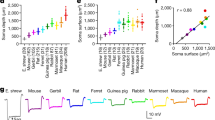Abstract.
The neocortex undergoes a complex transformation from mouse to whale. Whereas synapse density remains the same, neuron density decreases as a function of gray matter volume to the power of around −1/3, total convoluted surface area increases as a function of gray matter volume to the power of around 8/9, and white matter volume disproportionately increases as a function of gray matter volume to the power of around 4/3. These phylogenetic scaling relationships (including others such as neuron number, neocortex thickness, soma radius, and number of cortical areas) are clues to understanding the principles driving neocortex organization, but there is currently no theory that can explain why these neocortical quantities scale as they do. Here I present a two-part model that explains these neocortical allometric scaling laws. The first part of the model is a special case of the physico-mathematical model recently put forward to explain the quarter power scaling laws in biology. It states that the neocortex is a space-filling neural network through which materials are efficiently transported, and that synapse sizes do not vary as a function of gray matter volume. The second part of the model states that the neocortex is economically organized into functionally specialized areas whose extent of area-interconnectedness does not vary as a function of gray matter volume. The model predicts, among other things, that the number of areas and the soma radius increase as a function of gray matter volume to the power of 1/3 and 1/9, respectively, and empirical support is demonstrated for each. Also, the scaling relationships imply that, although the percentage of the total number of neurons to which a neuron connects falls as a function of gray matter volume with exponent −1/3, the network diameter of the neocortex is invariant at around two. Finally, I discuss how a similar approach may have promise in explaining the scaling relationships for the brain and other organs as a function of body mass.
Similar content being viewed by others
Author information
Authors and Affiliations
Additional information
Received: 23 December 1999 / Accepted in revised form: 2 August 2000
Rights and permissions
About this article
Cite this article
Changizi, M. Principles underlying mammalian neocortical scaling. Biol Cybern 84, 207–215 (2001). https://doi.org/10.1007/s004220000205
Issue Date:
DOI: https://doi.org/10.1007/s004220000205




